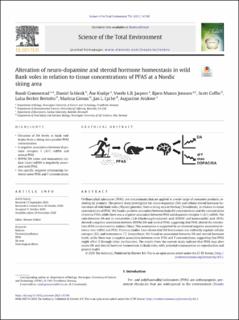| dc.contributor.author | Grønnestad, Randi | |
| dc.contributor.author | Schlenk, Daniel | |
| dc.contributor.author | Krøkje, Åse | |
| dc.contributor.author | Jaspers, Veerle | |
| dc.contributor.author | Jenssen, Bjørn Munro | |
| dc.contributor.author | Coffin, Scott | |
| dc.contributor.author | Bertotto, Luísa Becker | |
| dc.contributor.author | Giroux, Marissa | |
| dc.contributor.author | Lyche, Jan Ludvig | |
| dc.contributor.author | Arukwe, Augustine | |
| dc.date.accessioned | 2021-02-25T12:02:24Z | |
| dc.date.available | 2021-02-25T12:02:24Z | |
| dc.date.created | 2021-01-07T13:51:46Z | |
| dc.date.issued | 2020 | |
| dc.identifier.citation | Science of the Total Environment. 2020, 756, . | en_US |
| dc.identifier.issn | 0048-9697 | |
| dc.identifier.uri | https://hdl.handle.net/11250/2730401 | |
| dc.description.abstract | Perfluoroalkyl substances (PFAS) are contaminants that are applied in a wide range of consumer products, including ski products. The present study investigated the neuro-dopamine (DA) and cellular steroid hormone homeostasis of wild Bank voles (Myodes glareolus) from a skiing area in Norway (Trondheim), in relation to tissue concentrations of PFAS. We found a positive association between brain DA concentrations and the concentration of several PFAS, while there was a negative association between PFAS and dopamine receptor 1 (dr1) mRNA. The ratio between DA and its metabolites (3,4-dihydroxyphenylacetic acid: DOPAC and homovanillic acid: HVA) showed a negative association between DOPAC/DA and several PFAS, suggesting that PFAS altered the metabolism of DA via monoamine oxidase (Mao). This assumption is supported by an observed negative association between mao mRNA and PFAS. Previous studies have shown that DA homeostasis can indirectly regulate cellular estrogen (E2) and testosterone (T) biosynthesis. We found no association between DA and steroid hormone levels, while there was a negative association between some PFAS and T concentrations, suggesting that PFAS might affect T through other mechanisms. The results from the current study indicate that PFAS may alter neuro-DA and steroid hormone homeostasis in Bank voles, with potential consequences on reproduction and general health. | en_US |
| dc.language.iso | eng | en_US |
| dc.publisher | Elsevier | en_US |
| dc.rights | Navngivelse 4.0 Internasjonal | * |
| dc.rights.uri | http://creativecommons.org/licenses/by/4.0/deed.no | * |
| dc.title | Alteration of neuro-dopamine and steroid hormone homeostasis in wild Bank voles in relation to tissue concentrations of PFAS at a Nordic skiing area | en_US |
| dc.type | Peer reviewed | en_US |
| dc.type | Journal article | en_US |
| dc.description.version | publishedVersion | en_US |
| dc.source.volume | 756 | en_US |
| dc.source.journal | Science of the Total Environment | en_US |
| dc.identifier.doi | https://doi.org/10.1016/j.scitotenv.2020.143745 | |
| dc.identifier.cristin | 1867087 | |
| dc.description.localcode | This is an open access article distributed under the terms of the Creative Commons CC-BY license, which permits unrestricted use, distribution, and reproduction in any medium, provided the original work is properly cited. | en_US |
| dc.source.articlenumber | 143745 | en_US |
| cristin.ispublished | true | |
| cristin.fulltext | postprint | |
| cristin.qualitycode | 2 | |

